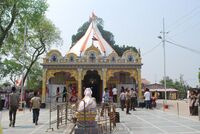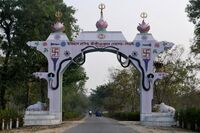Tejpur Assam
| Author:Laxman Burdak, IFS (R) |

Tezpur (तेज़पुर) is a city in Sonitpur district, Assam state, India. It is the district headquarter of Sonitpur district. Tezpur is on the banks of the river Brahmaputra, 175 kilometres northeast of Guwahati.
Origin
Variants
- Tezpur (तेज़पुर)
- Tejpur Assam (तेज़पुर) (असम) (AS, p.410)
History
Tourism
Tezpur has several places to visit:

Agnigarh: This hillock on bank of river Brahmaputra is the site of legendary romance of princess Usha (the only daughter of King Banasura) and Aniruddha, the grandson of Lord Krishna. According to legend, Usha was kept on this hillock which was surrounded by fire, hence the name of Agnigarh.[1]
Agnigarh is the site of the fortress which was built by Banasura to keep his daughter Usha in isolation. The name itself is derived from the words 'Agni' (meaning fire) and 'garh' (meaning fortress or wall) in Sanskrit.
Legend: Legend has it that this fortress was surrounded by fire at all times so that nobody could go in or out of the perimeter without permission. Usha fell in love with Aniruddha in her dreams, not knowing that he was the grandson of Krishna. Her companion Chitralekha identified him by painting his portrait from Usha's description. Chitralekha Udyan in Tezpur also known as 'Cole Park,' the biggest park in Tezpur, is named after her. Chitralekha was not only an artist but one possessing mystical powers. Anirudddha was Krishna's grandson and Usha, the daughter of an Asura king, therefore was no way any side would consent to their love. She flew one night and brought Aniruddha to Usha's place while he was still sleeping, using her powers. When Aniruddha opened his eyes and saw Usha, he fell in love immediately. However, Banasura was furious on knowing this, and tied him with snakes and imprisoned him. Lord Krishna, however had agreed for their marriage and had wanted for Banasura to consent for the same. Banasura was a great devotee of Lord Shiva, and as a boon had asked him and his entire family to guard the gates of his city, Tezpur. He therefore was not at all scared by Lord Krishna's wrath. A war ensued between the Hari (Lord Krishna and his followers) and the Hars (Lord Shiva and his followers), rivers of blood flowed and the city was named Tezpur (City of Blood). Both sides were nearly wiped out and a final battle followed between Lord Shiva and Lord Krishna, Lord Brahma requested both of them to stop the war by putting him between them. A discussion followed in which Lord Krishna made Lord Shiva see that Banasura was acting wrongly in imprisoning his grandson, and had even disrespected Lord Shiva himself in asking him and his family to be his gate keepers. Lord Shiva agreed, and Banasura was brought. Fearing his life he immediately agreed to the marriage.
The stone sculptures on the Agnigarh hill portray this entire picturesque story of love and great war.[2]

Mahabhairav Temple: The ancient temple of Mahabhairab stands to the north of Tezpur town. According to legend, the temple is believed to have been established by king Bana with a Siva lingam. Formerly, this temple was built of stone but the present one is built of concrete. During the later years, the Ahom kings donated devottar land for the Temple and Pujaris and Paiks were appointed to look after the temple.[3]]

Bamuni Hills: The ruins of Bamuni Hills are famous for their exemplary artistic finesse. The sculptural remains date back to the ninth and tenth century A.D.[4]
Chitralekha Udyan (Cole Park): It is one of the most beautiful places in Tezpur. Established by a British Deputy Commissioner, Mr. Cole in 1906, the park has two massive ornamented stone pillars, and other sculptural remnants . It was renovated and revitalized in 1996 under the stewardship of the then Deputy Commissioner, Mr. M.G.V.K.Bhanu, IAS. It has water sports facility, walk ways, restaurant and open air stage.[5]
Padum Pukhuri: This is a beautiful lake with an island. The island has been developed into a beautiful park with a musical fountain. There is an iron bridge to take you to the island. On the lake one can boat.[6]
Trimurty Udyan: This is a park along Borpukhuri. This has been named after the three jewels of Assamese culture: Rupkowar Jyoti Prasad Agarwalla, Kalaguru Bishnu Prasad Rabha and Natasurjya Phani Sarmah.[7]
Rudrapada Temple: To the east of Tezpur town, on the bank of river Brahmaputra the Rudrapada temple is situated. It is believed that Rudra (Lord Shiva) had left the print of his left foot (pada) on a stone found in the temple. It is believed that Mahadeva showed his real self to king Bana here. Rudrapada temple was later built by Siva Singha in the year 1730. The main temple was destroyed, due to erosion of river Brahmaputra.[8]
Bhomoraguri: It is a mammoth stone inscription made by the Ahom General Kalia Bhomora Borphukan, who planned to construct a bridge over Brahmaputra. Almost two centuries later, a bridge at the same site now stands completed. The 3.015 km bridge, named after the great Ahom general, connects Silghat of Nagaon district with Tezpur.[9]
The Hazara Pukhuri: It is a large tank in name of Harjar Varman in Tezpur. It was excavated in the early part of the 9th century.[10]

Singri - Singri is a beautiful place situated on the bank of river Brahmaputra, in Sonitpur district, Assam. It is known for Singri Tea Estate and Gupteshwar Temple as well as the ancient ruins of Vishwakarma's Temple. Main attraction of the place is Gupteswar temple. As mentioned by the great master Jigme Lingpa in the 18th century, Singri has been the pilgrimage site for Tibetans and Bhutanese, since the 14th century.
The Singri Temple is towards west of Tezpur town and is located on the bank of river Brahmaputra, within a distance of about 45 km .This temple has been mentioned in the Kalikapuran as Shringatak. It is said that one can attain penance worshipping it. As the Shiva Linga of this temple revered as God remains under water, the temple is also known as Gupteshwar. Derived from the word "Gupta" which means hidden and "Eshwar" denotes God. A big mela organised on Sivaratri in the Temple draws number of devotees to Singri.[11]

Ruins (Singri Hills) Singri - The remains appear to be of an ancient temple dated back to circa 11-12th century CE. The architectural members include mainly door frame, pillars, ceiling pieces, carved and chiseled stones etc. A door lintel (1.84 x 0.67 x 0.69m) contains the figures of Siva and Visnu, both are depicted in sthanaka posture. Another lintel (2.67 x0.60 x 0.77m) depicts the sculptures of two lions. Also two female figures are also depicted in standing posture holding lotuses in their hands along with the panel of the lions. The carved stones displays the figures of gandharbhas, dancing damsels, amorous scenes etc. [12]
Chutia or Sootea - is located under Naduar revenue circle, under Tezpur sub-division, formerly in the district of Sonitpur but at present in the district of Biswanath, Assam state, India. There is Arunachal Pradesh to the north of Sootea, south bank of the river Brahmaputra River to the south, river Ghiladhari to the east and river Dekorai to the west.
तेज़पुर (असम)
विजयेन्द्र कुमार माथुर[13] ने लेख किया है ...तेज़पुर) (असम) (AS, p.410): इस स्थान से गुप्तकालीन मूर्तियों के अनेक अवशेष प्राप्त हुए हैं. इनमें स्त्री-प्रतिमाओं की रचना की विशेषता यह है कि इनका वक्ष-स्थल समकालीन वाराणसी, बेसनगर आदि से प्राप्त प्रतिमाओं के प्रतिकूल अपेक्षाकृत क्षीण प्रदर्शित किया गया है जो पूर्व बंगाल तथा असम की नारियों की स्वाभाविक रूप रेखा का वास्तविक चित्रण जान पड़ता -- (देखें 'एज ऑफ दि इंपीरियल गुप्ताज' पृ.181)
External links
References
- ↑ https://sonitpur.gov.in/portlet-sub-innerpage/agnigarh
- ↑ "Agnigarh, Agnigarh The Love Site of Northeast, Agnigarh History, Agnigarh Assam, Usha Aniruddha Story". www.assaminfo.com.
- ↑ https://sonitpur.gov.in/portlet-sub-innerpage/mahabhairab-temple
- ↑ https://sonitpur.gov.in/portlet-sub-innerpage/bamuni-hills
- ↑ https://sonitpur.gov.in/portlet-sub-innerpage/chitralekha-udyan-cole-park
- ↑ https://sonitpur.gov.in/portlet-sub-innerpage/padum-pukhuri
- ↑ https://sonitpur.gov.in/portlet-sub-innerpage/trimurty-udyan
- ↑ https://sonitpur.gov.in/portlet-sub-innerpage/rudrapada-temple
- ↑ https://sonitpur.gov.in/portlet-sub-innerpage/bhomoraguri
- ↑ https://sonitpur.gov.in/portlet-sub-innerpage/the-hazara-pukhuri
- ↑ https://sonitpur.gov.in/portlet-sub-innerpage/singri-temple
- ↑ http://asiguwahaticircle.gov.in/singri%20hills.html
- ↑ Aitihasik Sthanavali by Vijayendra Kumar Mathur, p.410

